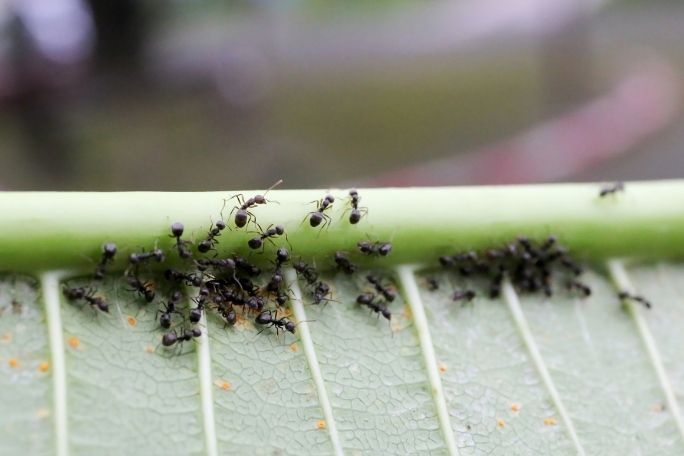Lesson summary
Students explore the features of invertebrates using descriptive language. They begin by exploring the value of descriptive terms (adjectives) in describing unfamiliar objects. They are then introduced to invertebrates and work in groups to generate a list of descriptive words and terms for familiar invertebrates. Students then head outside to observe an invertebrate and work independently to observe and describe this invertebrate. They then team up with a classmate to share their descriptions and their classmate has to draw the invertebrate based on the description provided by their partner. Finally, students create a ‘Who Am I?’ text around their invertebrate.
Learning intentions:
Students will...
- understand what an invertebrate is
- understand the value of descriptive language in communicating ideas.
Success criteria:
Students can...
- use adjectives and nouns to describe invertebrates
- use communication skills to share and transcribe information about invertebrates
- identify invertebrates in the schoolyard
- work independently and collaboratively
- participate in class and group discussion.
Lesson guides and printables
Curriculum links
Select your curriculum from the options below.
Lesson details
Curriculum mapping
Australian Curriculum content descriptions:
Year 3 English:
- use interaction skills to contribute to conversations and discussions to share information and ideas (AC9E3LY02)
- plan, create, edit and publish imaginative, informative and persuasive written and multimodal texts, using visual features, appropriate form and layout, with ideas grouped in simple paragraphs, mostly correct tense, topic-specific vocabulary and correct spelling of most high-frequency and phonetically regular words (AC9E3LY06)
Year 3 Science:
- compare characteristics of living and non-living things and examine the differences between the life cycles of plants and animals (AC9S3U01)
- write and create texts to communicate findings and ideas for identified purposes and audiences, using scientific vocabulary and digital tools as appropriate (AC9S3I06)
Year 4 English:
- listen for key points and information to carry out tasks and contribute to discussions, acknowledging another opinion, linking a response to the topic, and sharing and extending ideas and information (AC9E4LY02)
- plan, create, edit and publish written and multimodal imaginative, informative and persuasive texts, using visual features, relevant linked ideas, complex sentences, appropriate tense, synonyms and antonyms, correct spelling of multisyllabic words and simple punctuation (AC9E4LY06)
Year 4 Science:
- write and create texts to communicate findings and ideas for identified purposes and audiences, using scientific vocabulary and digital tools as appropriate (AC9S4I06)
Syllabus outcomes: EN2-1A, EN2-2A, ST2-10LW, ST2-4WS
General capabilities: Critical and creative thinking, Literacy
Cross-curriculum priority: Sustainability
Relevant parts of Year 3 English achievement standards: Students understand how language features, images and vocabulary choices are used for different effects. Students create a range of texts for familiar and unfamiliar audiences. They contribute actively to class and group discussions, asking questions, providing useful feedback and making presentations. They demonstrate understanding of grammar and choose vocabulary and punctuation appropriate to the purpose and context of their writing.
Relevant parts of Year 4 English achievement standards: Students explain how language features, images and vocabulary are used to engage the interest of audiences. Students create structured texts to explain ideas for different audiences. They contribute actively to class and group discussions, varying language according to context.
Relevant parts of Year 3 Science achievement standards: Students group living things based on observable features and use diagrams and other representations to communicate their ideas.
Relevant parts of Year 4 Science achievement standards: Students make and record observations with accuracy, and use formal and informal ways to communicate their observations and findings.
This lesson is part of the wider unit of work: Investigating Invertebrates – Lower Primary
Resources required
- Device capable of presenting a website to the class
- Drawing materials
- Invertebrate Flashcards – Years 3 & 4
- Student Worksheet – one copy per student
- Whiteboard
- Who Am I? Example
Skills
This lesson is designed to build students’ competencies in the following skills:
- Communication
- Creativity
- Critical thinking
- Collaboration
Additional info
Time required: 90 mins
Level of teacher scaffolding: Medium – lead students in discussions, oversee observations of invertebrates outdoors
This is an original Cool+ lesson.


Welcome back!
Don't have an account yet?
Log in with:
Create your free Cool.org account.
Many of our resources are free, with an option to upgrade to Cool+ for premium content.
Already have an account?
Sign up with:
By signing up you accept Cool.org's Terms and Conditions(Opens in new tab) and Privacy Policy(Opens in new tab).